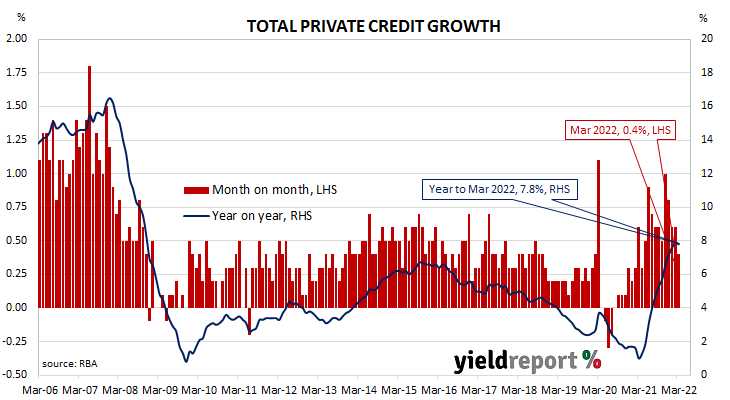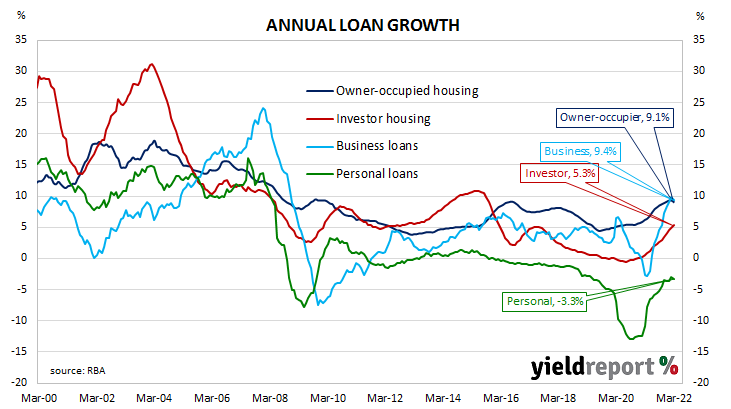Summary: Private sector credit up 0.4% in March; below expectations; annual growth rate slips from 7.9% to 7.8%; owner-occupiers leading lending growth; housing credit growth set to cool; investor loans account for about 45% of net growth in March, owner-occupiers loans 30%.
The pace of lending to the non-bank private sector by financial institutions in Australia followed a steady-but-gradual downtrend from late-2015 through to early 2020 before hitting what appears to be a nadir in March 2021. That downtrend ended later in the same year and now annual growth rates are above the peak rate seen in the previous decade.
According to the latest RBA figures, private sector credit increased by 0.4% in March. The result was below expectations as well as February’s 0.6% increase. On an annual basis, the growth rate slipped from 7.9% to 7.8%.
“Owner-occupiers have led this cycle, with annual growth for the segment at 9.1%…the strongest annual pace since mid-2008. Investors have returned in greater numbers of late, with annual growth lifting to be at 5.3% currently,” said ANZ senior economist Andrew Hanlan.
Commonwealth Government bond yields rose modestly on the day. By the close of business, the 3-year ACGB yield had gained 3bps to 2.86%, the 10-year yield had added 4bps to 3.17% while the 20-year yield finished 2bps higher at 3.45%.
In the cash futures market, expectations of any material change in the actual cash rate, currently at 0.06%, eased a little in regard to rate rises over the next four months but firmed in regard to late-2022 and early 2023. At the end of the day, contract prices implied the cash rate would not exceed the RBA’s 0.10% target rate until May and then rise to 0.53% by June and 1.34% by August. February 2023 contracts implied a cash rate of 2.725%.
“Looking ahead, housing credit growth is set to cool with an imminent RBA tightening cycle, likely beginning with a rate rise at the May meeting,” Hanlan added. He noted there were already “tentative signs” the owner-occupier market is cooling.
Investor loans accounted for a little over 45% of the net growth over the month, while owner-occupier loans and business loans accounted for a little over 30% and 20% respectively. Total personal debt contracted.
The traditional driver of loan growth rates, the owner-occupier segment, grew by 0.6% over the month, slightly lower than February’s 0.7% increase. The sector’s 12-month growth rate slowed from 9.3% to 9.1%.
Total lending in the business sector rose by 0.3%, down from the 0.8% increase recorded in February. The segment’s annual growth rate slowed from 9.8% to 9.4%.
Monthly growth in the investor-lending segment slowed to a halt in early 2018. Shortly into the 2019/20 financial year, monthly growth rates slipped into the red before posting a series of flat or near-flat results until mid-2020.
In March, net lending grew by 0.6%, up from February’s 0.5% increase. The 12-month growth rate accelerated from 4.9% to 5.3%.
Total personal loans contracted by 0.2%, down from February’s flat result, taking the annual contraction rate from 3.0% to 3.3%. This category of debt includes fixed-term loans for large personal expenditures, credit cards and other revolving credit facilities.



